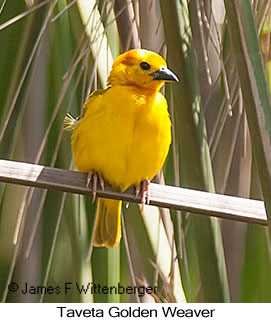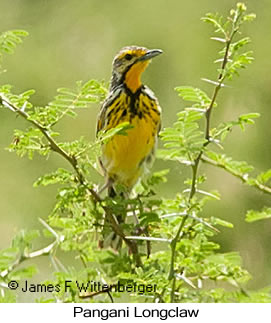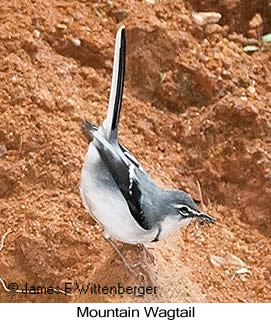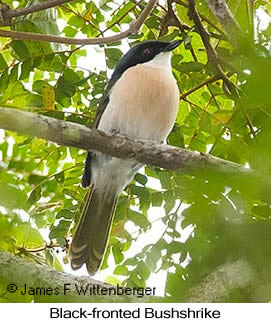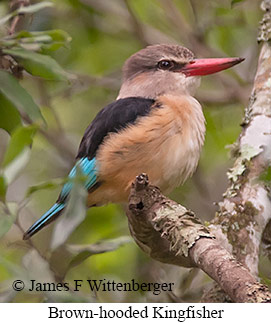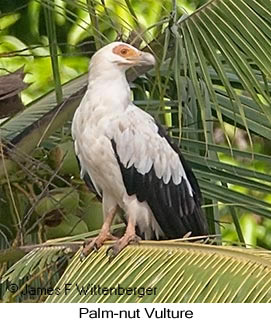TANZANIA BIRDING TRIP REPORT

TRIP REPORT
TANZANIA
| Start: | 06/01/2014 |
| End: | 06/07/2014 |
| Duration: | 7 days |
| #Species: | 206 |
| #Endemics: | 11 |
| #Heard Only: | 7 |
2014 Northeastern Tanzania Birding Scouting Trip
TOUR DESCRIPTION
The extension of our scouting trip to Tanzania covered some roadside areas near the base of the North and South Pare mountains including the reservoir area, Mkomazi National Park, and the Usambara Mountains. We had originally intended to visit Pemba Island overnight, but a change in flight schedules made it impossible to see the 4 endemics there with a single overnight stay, so we stayed an extra night in Amani instead.
We left Arusha early June 1 for the village of Same with a plan of birding en route. At a brief roadside stop near the North Pare Mountains we picked up Black Crake and Taveta Golden-Weaver in a small wetland and creek area. We then took a side road through arid scrub to a reservoir. The reservoir provided very distant views of Maccoa Duck, Long-toed Lapwing, Spur-winged Plover and better views of Lesser Swamp Warbler, Red-fronted Warbler along with several species of herons and egrets. We saw our only Rufous-crowned Roller on a wire near the reservoir. On the way back we walked through the scrub and picked up White-bellied Go-away-bird, Blue-naped Mousebird, Black-throated Barbet, D'Arnaud's Barbet, Pygmy Batis, Pringle's Puffback, and Green-winged Pytilia. We had decent looks at Rosy-patched Bushshrike (which took some effort as it stayed hidden mostly in thick thorn bush), Pink-breasted Lark, Mouse-colored Penduline-Tit, Tiny Cisticola, African Bare-eyed Thrush, and Hunter's Sunbird, most of our main target birds there. We also saw Brown-headed Apalis, a rarity for the area. We spent the night at the Elephant Motel, a decent but fairly basic place in Same.
The morning of June 2 we did a game drive through Mkomazi National Park, an extension of Tsavo West National Park in southern Kenya. Mkomazi features heavily bushed savanna, which during May is covered with tall lush green grass as well as numerous thorn bushes. At the end of the rains, mammals are mostly north in Tsavo. We did see a couple Giraffes as well as Kirk's Dikdik and a brief look at a Steenbok as it darted across the road into the thick grass. The most notable bird seen briefly several times was Harlequin Quail as it quickly flew into dense underbrush. Other birds of note we saw were Helmeted Guineafowl, Tawny Eagle perched in a tree, African Goshawk that flew past our vehicle and disappeared, Emerald-spotted Wood-Dove, Northern Red-billed Hornbill, which is at the southern-most extent of its range at Mkomazi, Rattling Cisticola, Ashy Cisticola (one of our target birds), Tsavo Sunbird (another target species), Pangani Longclaw (another target species that we finally saw perched in a thorn bush as we were approaching the exit to the park), and the locally distributed Jameson's Firefinch. We then proceeded to the West Usambara Mountains and Mueller's Mountain Resort. En route we saw Shelley's Starling (an uncommon species that appears erratically). The side road leading up to the resort winds its way up the mountain and takes about 1½ hours to reach the resort. Numerous villages and farms are present along the way, and the local population is pressuring the forest reserve. We stopped several times during the transfer and picked up African Swift, Gray-headed Kingfisher, Little Bee-eater, Pygmy Falcon, a female Black-bellied Sunbird, African Golden-Weaver, White-winged Widowbird, Pin-tailed Whydah, and Broad-tailed Whydah. We spent the next two nights at Mueller's Resort, a very pleasant place to stay.
All next day (June 3) we birded a couple sections of road through the forest reserve above the resort. The morning was very gray sky with flat light, making it difficult to see colors on the birds we saw. The forest is very dense, especially in the understory, making birding a bit difficult. We saw the Usambara race of Shelley's Greenbul, a possible future split, and with effort had very good looks at Fuelleborn's Boubou, a skulker that briefly perched on an open branch. A super skulker is the Spot-throat, which we heard but could never see. Other birds of note were Hartlaub's Turaco, seen briefly and backlit high in the canopy of a tree, Cinnamon-chested Bee-eater, White-eared Barbet, Pallid Honeyguide, Olive Woodpecker, Short-tailed Batis, Black-fronted Bushshrike (seen quite well several times) Gray Cuckooshrike (seen briefly as it flew off), White-tailed Crested-Flycatcher, Usambara Drongo (sometimes split from Fork-tailed Drongo and only present in the West Usambara Mountains), Terrestrial Brownbul (seen briefly as it flew across the dirt track), Yellow-throated Wood-Warbler, Evergreen Forest-Warbler (seen very well as it perched in a dark open spot at the base of a bush), African Tailorbird (quite common but a bit difficult to see well in the thick tree branches where it is typically found), Red-winged Starling, Usambara Double-collared Sunbird, Mountain Wagtail (always found near water), and Yellow-bellied Waxbill (seen by the guide only). Of special note was Magpie Mannikin, a rarity in the West Usambara Mountains.
The following morning we re-visited some of the areas birded the previous day. The light was a bit better but it was still mostly overcast. We got a much better look at African Tailorbird singing from an open perch and flitting about. We also had very good though somewhat distant looks at Usambara Weaver, an endangered species that is always in flocks and only occasionally seen. We saw a strikingly different race of Black-fronted Bushshrike which occurs as 5 distinctive races that all co-exist. We didn't see any raptors, which are mostly present from November-May. Bird activity slowed by the time we went for breakfast at 8:30, and rain began coming down after breakfast. We drove back to the main highway en route to the Amani Forest Reserve in the eastern Usambara Mountains. The drive takes most of the day as it's a long way around. We did stop at the Pangani River and picked up Coastal Cisticola and Tawny-flanked Prinia. Other birds we saw en route included African Openbill and Zanzibar Bishop. We arrived at the Amani Guest House in late afternoon. Normally, birders spend two nights at the upper accommodations and bird the lower section of the reserve on the way out, but since we had 3 nights, we stayed the first night at the lower accommodations near the reserve entrance. Accommodations are very basic at Amani and the food is quite monotonous. The site is basically a research station and not recommended for persons intolerant of rustic conditions.
The morning of June 5 was very overcast and wet. It had rained all night although the rain had stopped by 6:30am. We birded the road near the guest house and picked up a number of species. We briefly saw an Ayre's Hawk-Eagle as it flew off low through the forest. We saw Trumpeter Hornbills flying overhead. This species is quite common at Amani and was seen perched and flying many times. We had decent looks at Mombassa Woodpecker, a coastal specialty. Other birds of note were Gray Cuckooshrike, African Black-headed Oriole (one of our target species and seen well), Eastern Nicator (a rarely seen bird that we saw rather briefly and in poor light), Yellow Flycatcher, Little Greenbul, Plain-backed Sunbird (a pair seen very well), Uluguru Violet-backed Sunbird, a female Banded Sunbird, and Dark-backed Weaver.
After lunch we drove up the mountain to the upper part of the reserve for 2 nights there. Lots of people are about. The government plans to eventually relocate them outside the reserve, but currently people are constantly going up and down the road to and from nearby villages on motorbikes or walking. Many of the women carry milk buckets on their heads. A government project that provided the people with milk cows and a collection depot for collecting milk in exchange for cash was instituted to discourage cutting down the forest, but some cutting still occurs. The project seems to be largely successful. Birding is along the main road where traffic is constant, on side trails through open or forest edge areas, and along trails through deep forest. That afternoon we mainly birded the main road in the upper reserve. Notable birds we saw included African Green-Pigeon, Green Barbet (a target species), African Golden Oriole, Southern Black-Flycatcher, Waller's Starling, Collared Sunbird, Eastern Olive Sunbird, Purple-banded Sunbird, Cabanis's Bunting, Southern Citril (a recent split from African Citril), Spectacled Weaver, and Black-and-white Mannikin.
The morning of June 6 began sunny with blue sky though it later became a bit overcast. The plan was to bird the deep forest, but Anthony's IPod stopped working so we couldn't use playback. The forest was quiet and without playback we were seeing nothing. So, we back-tracked and took a different trail that followed forest edge. We had good looks at a Southern Banded Snake-Eagle perched on a pole as well as excellent looks at Black-bellied Glossy-Starling, one of our target species. We also saw a prized Amani Sunbird (a target species only occasionally seen by visitors) before it was chased away by an Uluguru Violet-backed Sunbird. Other notable birds we saw included African Goshawk, Little Sparrowhawk (it was a decent day for raptors), Lemon Dove (seen in the deep forest by the guide only), Brown-hooded Kingfisher, Green-backed Honeyguide, Cabanis's Greenbul, Fischer's Greenbul, Green-backed Camaroptera, and Red-faced Crimsonwing (a brief and distant view before it flew off).
Our last day (June 7) was a transfer day. It's a long drive to Dar es Salaam from Amani and we had arranged to meet a private taxi at the junction circle where the road to Dar connects in. Due to the very heavy traffic on the outskirts of Dar, where we encountered hundreds of trucks blocking most of the main highway waiting for access to the weigh stations, it took about 10 hours to reach the airport. We did see a few birds en route including great looks at our only Palm-nut Vulture, a species that eats palm nuts instead of scavenging animal carcasses. We also saw our only Yellow-billed Kite of the trip, a species usually lumped with Black Kite, and our only House Crows seen during the extension. The flight home was brutal. We caught an evening flight from Dar es Salaam to Nairobi, spent an hour and a half there before catching an overnight 9-hour flight to London followed by a 10-hour layover before finally catching another 10-hour overnight flight home. It's the price we Americans must pay to enjoy the great birding and mammal watching available in East Africa.
BIRDING LOCALES
